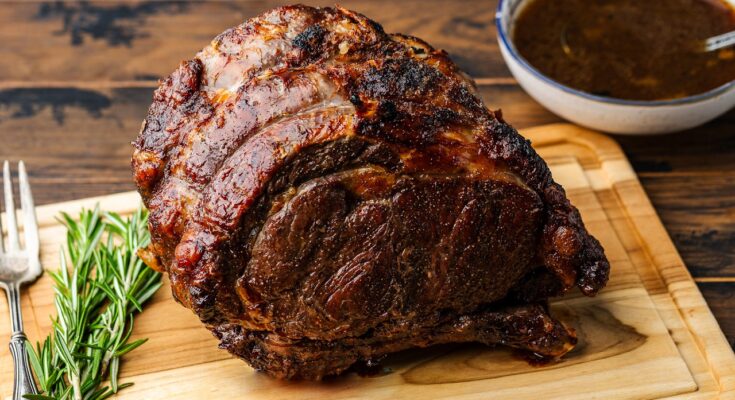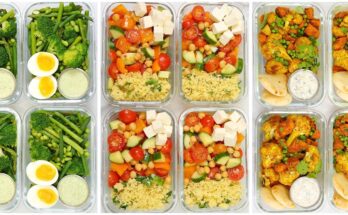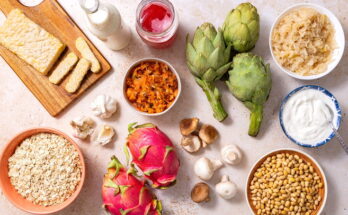Prime Rib Roast Recipe: Prime rib roast is a show-stopping centerpiece for any festive occasion. Known for its tender, juicy meat and rich flavor, this dish is as impressive as it is delicious. But don’t let its grandeur intimidate you—making a perfect prime rib roast at home is easier than you think when you follow the right steps.
What makes prime rib so special?
It’s all about the cut of meat, known for its marbling, tenderness, and robust flavor. This guide will walk you through everything, from selecting the best cut to cooking it perfectly. Let’s dive in and transform your next gathering into an unforgettable feast!
Selecting the Right Cut of Prime Rib
Prime vs. Choice: What to Look For
When shopping for a prime rib roast, the label “Prime” refers to USDA grading, indicating the highest quality of meat with superior marbling. However, “Choice” cuts are also excellent and more budget-friendly.
Look for:
- Bright red color.
- Generous marbling (white streaks of fat).
- A fresh, clean aroma.
Bone-In or Boneless: Which Should You Choose?
Bone-in cuts retain more moisture during cooking, resulting in a juicier roast with added flavor. Boneless cuts are easier to carve and still produce excellent results. If you’re serving a smaller group, a boneless cut might be more convenient.
How Much Prime Rib Do You Need Per Person?
- For bone-in: Plan for one pound per person.
- For boneless: About ¾ pound per person.
Ingredients for a Perfect Prime Rib Roast
Simple Ingredients List
- Prime Rib Roast (5-7 lbs for a medium-sized roast).
- Salt and Black Pepper (coarse).
- Fresh Garlic Cloves (minced).
- Olive Oil.
- Fresh Herbs (rosemary, thyme, or parsley).
Optional Seasonings for Enhanced Flavor
- Paprika.
- Onion powder.
- Dijon mustard for an extra tangy crust.
Preparing the Prime Rib
Trimming and Cleaning the Meat
Start by trimming excess fat, leaving a thin layer for flavor. Rinse the meat under cold water and pat it dry with paper towels.
How to Create the Perfect Rub
Combine salt, pepper, minced garlic, olive oil, and your choice of herbs. The mixture should form a paste that can coat the roast evenly.
- Massage the rub into the meat thoroughly.
- Don’t forget to rub between the bones if using a bone-in cut.
Marinating vs. Dry Rub: Which Works Best?
For prime rib, a dry rub is ideal because it allows the roast’s natural flavors to shine. Marinating can add additional flavors but may overpower the meat’s natural richness.
Step-by-Step Cooking Process
Preheating the Oven
Preheat your oven to 450°F (232°C) for an initial high-heat sear. This step locks in juices and creates a flavorful crust.
Searing the Prime Rib for Maximum Flavor
- Place the roast in a roasting pan, fat side up.
- Sear it in the oven for 15-20 minutes at 450°F.
Roasting and Monitoring Internal Temperature
After searing, reduce the oven temperature to 325°F (163°C). Use a meat thermometer to check the internal temperature:
- Rare: 120-125°F (49-52°C).
- Medium Rare: 130-135°F (54-57°C).
- Medium: 135-140°F (57-60°C).
- Well Done: 145°F+ (63°C).
Place a thermometer probe into the thickest part of the meat for accurate readings.
Rare, Medium, and Well-Done Temperature Guidelines
Achieving the desired doneness for your prime rib is crucial. Here’s a detailed breakdown to ensure your roast is cooked to perfection:
| Doneness Level | Internal Temperature | Appearance |
|---|---|---|
| Rare | 120–125°F (49–52°C) | Cool, red center, very tender. |
| Medium Rare | 130–135°F (54–57°C) | Warm, red center, slightly firm. |
| Medium | 135–140°F (57–60°C) | Pink center with some firmness. |
| Medium Well | 140–145°F (60–63°C) | Slightly pink center, firmer texture. |
| Well Done | 145°F+ (63°C+) | Fully cooked, little to no pink. |
To avoid overcooking, always remove the roast from the oven 5-10°F before reaching your target temperature. The meat will continue to cook as it rests.
Resting the Meat Before Slicing
Once the roast reaches the desired temperature, remove it from the oven and tent it loosely with aluminum foil. Allow it to rest for 20–30 minutes. Resting lets the juices redistribute throughout the meat, ensuring every bite is tender and flavorful.
Serving the Prime Rib
How to Slice Prime Rib Properly
Using a sharp carving knife, slice the prime rib against the grain into ½-inch to 1-inch thick slices. For bone-in roasts, carve along the bones first to separate them, then slice the meat.
Here are some tips for precise slicing:
- Use a carving fork to steady the roast.
- Ensure even slices for better presentation.
- For extra flavor, spoon pan drippings over each slice before serving.
Side Dishes to Complement Your Roast
Pair your prime rib roast with these classic sides for a balanced meal:
- Garlic Mashed Potatoes: Creamy and buttery to complement the meat.
- Yorkshire Pudding: A traditional and savory choice.
- Creamed Spinach: Rich and velvety for added indulgence.
- Roasted Vegetables: Carrots, Brussels sprouts, and asparagus add a vibrant touch.
- Horseradish Sauce: Offers a tangy kick to balance the richness of the beef.
Storing Leftovers and Reheating Tips
Prime rib leftovers can be just as delicious if stored and reheated properly:
- Storing: Wrap slices tightly in aluminum foil or an airtight container and refrigerate for up to 3-4 days.
- Reheating: Warm slices in a 250°F (121°C) oven for 10–15 minutes to retain moisture. Avoid microwaving, as it can dry out the meat.
FAQs about Prime Rib Roast Recipe
What is a prime rib roast?
A prime rib roast, also known as a standing rib roast, is a flavorful cut of beef taken from the rib section. It’s a popular choice for special occasions due to its tenderness and rich taste.
How do I prepare a prime rib roast?
To prepare a prime rib roast, season it generously with salt, pepper, and your favorite herbs. Allow it to come to room temperature before roasting at a low temperature to ensure even cooking and a tender texture.
What is the best cooking temperature for a prime rib roast?
For optimal results, roast the prime rib at 250°F (120°C) until it reaches your desired level of doneness. Use a meat thermometer to ensure accuracy.
How long should I let the prime rib rest after cooking?
Let the roast rest for 20–30 minutes after removing it from the oven. This allows the juices to redistribute, ensuring a moist and flavorful cut.
What side dishes pair well with prime rib roast?
Classic side dishes include mashed potatoes, roasted vegetables, Yorkshire pudding, and a fresh green salad. These complement the rich flavors of the prime rib.
Conclusion
Cooking a prime rib roast may seem intimidating at first, but with this detailed step-by-step guide, you’re well on your way to mastering the art of this luxurious dish. From selecting the right cut to achieving the perfect doneness, each stage is designed to ensure your roast is tender, flavorful, and unforgettable. Whether it’s for a holiday feast or a special celebration, your guests are sure to be impressed.



